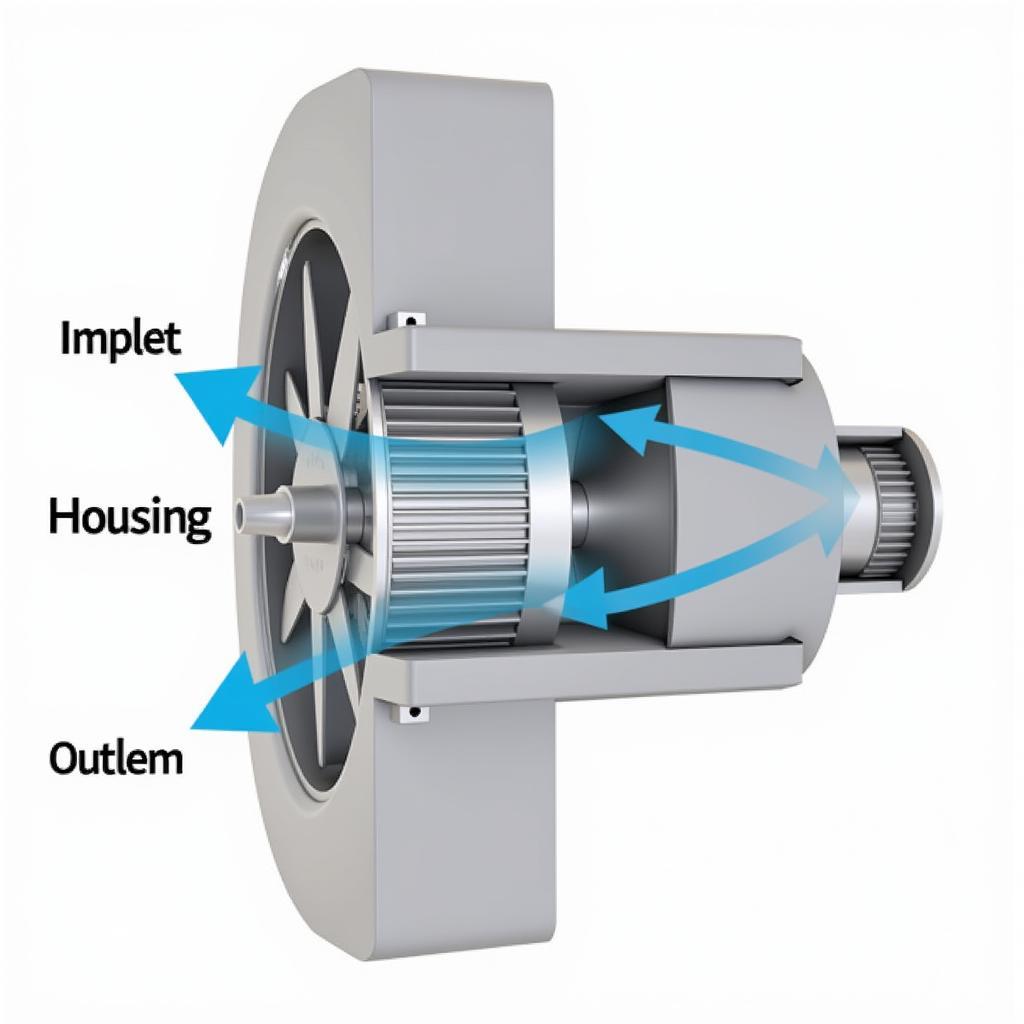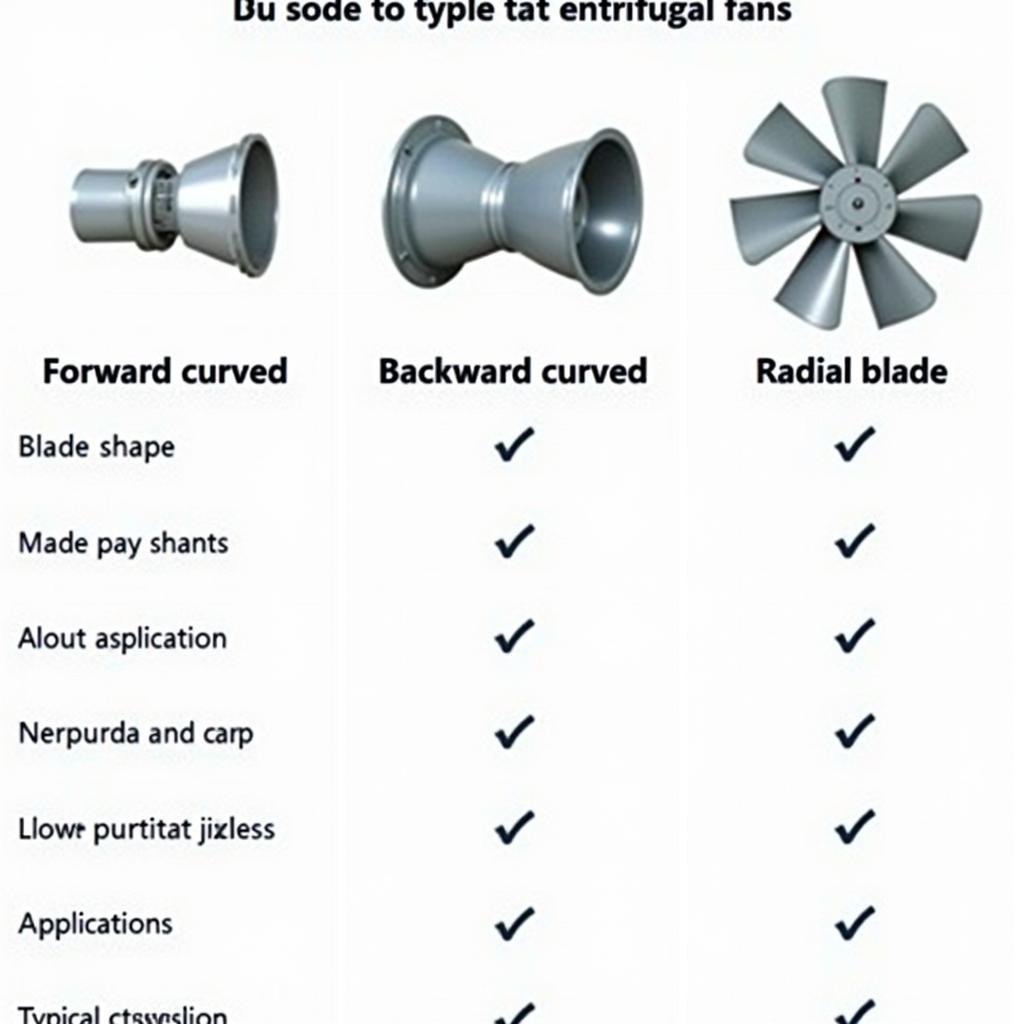Centrifugal fans are essential components in numerous industrial and commercial applications, from HVAC systems to manufacturing processes. Understanding the Centrifugal Fan Operating Principle is crucial for selecting the right fan, optimizing performance, and troubleshooting potential issues. This article delves into the mechanics of how these fans work, exploring the key principles behind their operation.
A centrifugal fan operates by converting rotational energy into kinetic energy, ultimately generating airflow. This conversion is achieved through the impeller, the core component of the centrifugal fan. The impeller rotates at high speed, drawing air into the fan’s inlet. Check out our article on cooling fan air flow calculation for more details.
The Key Components and Their Roles
A centrifugal fan comprises several key components working together to generate airflow:
- Impeller: The heart of the fan, designed with curved blades that accelerate the air. Impellers come in various designs, each optimized for specific applications.
- Housing: Encloses the impeller and directs the airflow. The housing’s shape and size influence the fan’s performance characteristics.
- Inlet: The opening where air enters the fan. Its design affects the air intake efficiency and noise levels.
- Outlet: The opening where the accelerated air exits the fan, typically connected to ductwork.
- Drive Mechanism: Usually an electric motor that provides the rotational energy to the impeller.
How a Centrifugal Fan Works: A Step-by-Step Guide
- Air Intake: Air enters the fan through the inlet, typically located at the center of the impeller.
- Impeller Rotation: The impeller, driven by the motor, rotates at high speed.
- Centrifugal Force: As the impeller spins, the air drawn into the center is subjected to centrifugal force. This force pushes the air outwards towards the tips of the impeller blades.
- Kinetic Energy Conversion: The centrifugal force converts rotational energy into kinetic energy, accelerating the air.
- Air Discharge: The accelerated air is then directed by the housing towards the outlet, where it exits the fan with increased velocity and pressure.
- Airflow Generation: This continuous process creates a consistent airflow, providing ventilation, cooling, or other desired effects.
 Centrifugal Fan Components Diagram
Centrifugal Fan Components Diagram
Different Types of Centrifugal Fans
Centrifugal fans are categorized based on several factors, including blade curvature, housing design, and airflow direction. Understanding these distinctions is crucial for selecting the right fan for a particular application. Learn more about different fan types in our article on the difference between id fan and fd fan.
Forward Curved Fans
Forward curved fans are known for their quiet operation and high efficiency at lower speeds.
Backward Curved Fans
Backward curved fans offer good efficiency and stable performance over a wider range of operating conditions.
Radial Blade Fans
Radial blade fans are robust and capable of handling dusty or particulate-laden air streams.
 Comparison of Centrifugal Fan Types
Comparison of Centrifugal Fan Types
“Choosing the right centrifugal fan involves careful consideration of factors like airflow requirements, pressure drop, and operating environment,” explains Dr. Amelia Hernandez, a mechanical engineer specializing in ventilation systems. “Understanding the fundamental operating principle helps in making informed decisions.”
Optimizing Centrifugal Fan Performance
Several factors can influence the performance of a centrifugal fan. Regular maintenance, proper installation, and appropriate selection based on application requirements are key to ensuring optimal operation. For insights into fan design, refer to our article on centrifugal fan design calculations.
- Regular Cleaning: Dust and debris accumulation can impede airflow and reduce efficiency.
- Proper Blade Alignment: Ensuring proper blade alignment optimizes airflow and minimizes vibrations.
- Motor Maintenance: Regular motor checks and maintenance ensure consistent performance and prevent unexpected downtime.
“Efficient operation not only saves energy but also prolongs the lifespan of the fan,” adds Dr. Hernandez. “Regular inspections and preventive maintenance are crucial for long-term reliability.”
Conclusion
The centrifugal fan operating principle, based on the conversion of rotational energy into kinetic energy, is a fundamental concept in numerous applications. Understanding this principle, along with the different types of centrifugal fans and optimization techniques, allows for efficient selection, operation, and maintenance. This knowledge ensures optimal performance, longevity, and cost-effectiveness in various industrial and commercial settings. By grasping the centrifugal fan operating principle, you can effectively harness the power of these versatile devices. Learn more about specialized fan applications in our article on cooling tower liang chi fan. For inquiries about chemical resistant fans, see our article about chemical resistance frp fan manufacturers.
FAQ
- What is the main operating principle of a centrifugal fan? Centrifugal force pushes air outwards, converting rotational energy into kinetic energy, creating airflow.
- What are the key components of a centrifugal fan? Impeller, housing, inlet, outlet, and drive mechanism.
- What are the different types of centrifugal fans? Forward curved, backward curved, and radial blade.
- How can I optimize centrifugal fan performance? Regular cleaning, proper blade alignment, and motor maintenance.
- Why is understanding the centrifugal fan operating principle important? It’s crucial for selecting the right fan, optimizing performance, and troubleshooting issues.
- What drives the impeller in a centrifugal fan? Typically an electric motor.
- How does the housing of a centrifugal fan contribute to its operation? It directs the airflow created by the impeller.
Need support? Contact us at Phone Number: 0903426737, Email: fansbongda@gmail.com or visit our address: Lot 9, Area 6, Gieng Day Ward, Ha Long City, Gieng Day, Ha Long, Quang Ninh, Vietnam. We have a 24/7 customer support team.


